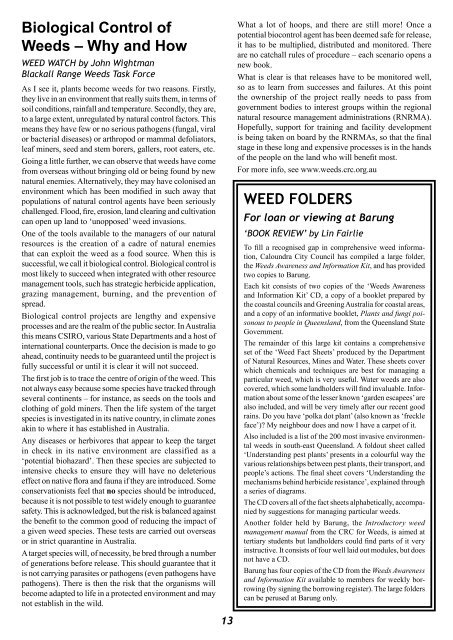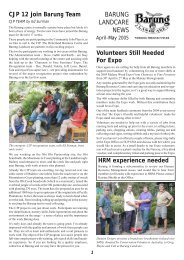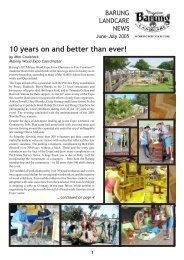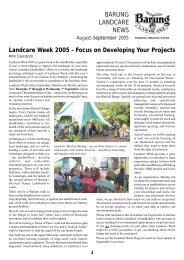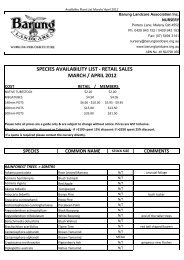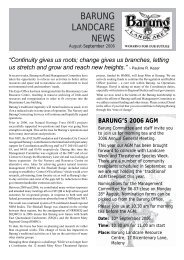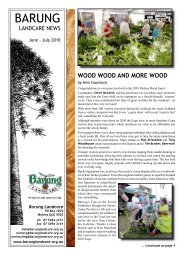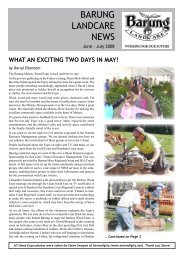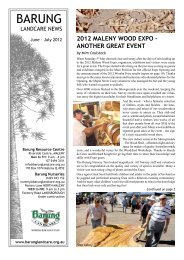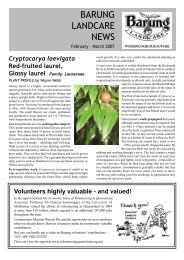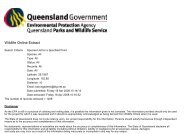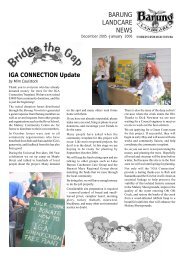Apr/May 2007 - Barung Landcare
Apr/May 2007 - Barung Landcare
Apr/May 2007 - Barung Landcare
Create successful ePaper yourself
Turn your PDF publications into a flip-book with our unique Google optimized e-Paper software.
Biological Control of<br />
Weeds – Why and How<br />
WEED WATCH by John Wightman<br />
Blackall Range Weeds Task Force<br />
As I see it, plants become weeds for two reasons. Firstly,<br />
they live in an environment that really suits them, in terms of<br />
soil conditions, rainfall and temperature. Secondly, they are,<br />
to a large extent, unregulated by natural control factors. This<br />
means they have few or no serious pathogens (fungal, viral<br />
or bacterial diseases) or arthropod or mammal defoliators,<br />
leaf miners, seed and stem borers, gallers, root eaters, etc.<br />
Going a little further, we can observe that weeds have come<br />
from overseas without bringing old or being found by new<br />
natural enemies. Alternatively, they may have colonised an<br />
environment which has been modified in such away that<br />
populations of natural control agents have been seriously<br />
challenged. Flood, fire, erosion, land clearing and cultivation<br />
can open up land to ‘unopposed’ weed invasions.<br />
One of the tools available to the managers of our natural<br />
resources is the creation of a cadre of natural enemies<br />
that can exploit the weed as a food source. When this is<br />
successful, we call it biological control. Biological control is<br />
most likely to succeed when integrated with other resource<br />
management tools, such has strategic herbicide application,<br />
grazing management, burning, and the prevention of<br />
spread.<br />
Biological control projects are lengthy and expensive<br />
processes and are the realm of the public sector. In Australia<br />
this means CSIRO, various State Departments and a host of<br />
international counterparts. Once the decision is made to go<br />
ahead, continuity needs to be guaranteed until the project is<br />
fully successful or until it is clear it will not succeed.<br />
The first job is to trace the centre of origin of the weed. This<br />
not always easy because some species have tracked through<br />
several continents – for instance, as seeds on the tools and<br />
clothing of gold miners. Then the life system of the target<br />
species is investigated in its native country, in climate zones<br />
akin to where it has established in Australia.<br />
Any diseases or herbivores that appear to keep the target<br />
in check in its native environment are classified as a<br />
‘potential biohazard’. Then these species are subjected to<br />
intensive checks to ensure they will have no deleterious<br />
effect on native flora and fauna if they are introduced. Some<br />
conservationists feel that no species should be introduced,<br />
because it is not possible to test widely enough to guarantee<br />
safety. This is acknowledged, but the risk is balanced against<br />
the benefit to the common good of reducing the impact of<br />
a given weed species. These tests are carried out overseas<br />
or in strict quarantine in Australia.<br />
A target species will, of necessity, be bred through a number<br />
of generations before release. This should guarantee that it<br />
is not carrying parasites or pathogens (even pathogens have<br />
pathogens). There is then the risk that the organisms will<br />
become adapted to life in a protected environment and may<br />
not establish in the wild.<br />
What a lot of hoops, and there are still more! Once a<br />
potential biocontrol agent has been deemed safe for release,<br />
it has to be multiplied, distributed and monitored. There<br />
are no catchall rules of procedure – each scenario opens a<br />
new book.<br />
What is clear is that releases have to be monitored well,<br />
so as to learn from successes and failures. At this point<br />
the ownership of the project really needs to pass from<br />
government bodies to interest groups within the regional<br />
natural resource management administrations (RNRMA).<br />
Hopefully, support for training and facility development<br />
is being taken on board by the RNRMAs, so that the final<br />
stage in these long and expensive processes is in the hands<br />
of the people on the land who will benefit most.<br />
For more info, see www.weeds.crc.org.au<br />
WEED FOLDERS<br />
For loan or viewing at <strong>Barung</strong><br />
‘BOOK REVIEW’ by Lin Fairlie<br />
To fill a recognised gap in comprehensive weed information,<br />
Caloundra City Council has compiled a large folder,<br />
the Weeds Awareness and Information Kit, and has provided<br />
two copies to <strong>Barung</strong>.<br />
Each kit consists of two copies of the ‘Weeds Awareness<br />
and Information Kit’ CD, a copy of a booklet prepared by<br />
the coastal councils and Greening Australia for coastal areas,<br />
and a copy of an informative booklet, Plants and fungi poisonous<br />
to people in Queensland, from the Queensland State<br />
Government.<br />
The remainder of this large kit contains a comprehensive<br />
set of the ‘Weed Fact Sheets’ produced by the Department<br />
of Natural Resources, Mines and Water. These sheets cover<br />
which chemicals and techniques are best for managing a<br />
particular weed, which is very useful. Water weeds are also<br />
covered, which some landholders will find invaluable. Information<br />
about some of the lesser known ‘garden escapees’ are<br />
also included, and will be very timely after our recent good<br />
rains. Do you have ‘polka dot plant’ (also known as ‘freckle<br />
face’)? My neighbour does and now I have a carpet of it.<br />
Also included is a list of the 200 most invasive environmental<br />
weeds in south-east Queensland. A foldout sheet called<br />
‘Understanding pest plants’ presents in a colourful way the<br />
various relationships between pest plants, their transport, and<br />
people’s actions. The final sheet covers ‘Understanding the<br />
mechanisms behind herbicide resistance’, explained through<br />
a series of diagrams.<br />
The CD covers all of the fact sheets alphabetically, accompanied<br />
by suggestions for managing particular weeds.<br />
Another folder held by <strong>Barung</strong>, the Introductory weed<br />
management manual from the CRC for Weeds, is aimed at<br />
tertiary students but landholders could find parts of it very<br />
instructive. It consists of four well laid out modules, but does<br />
not have a CD.<br />
<strong>Barung</strong> has four copies of the CD from the Weeds Awareness<br />
and Information Kit available to members for weekly borrowing<br />
(by signing the borrowing register). The large folders<br />
can be perused at <strong>Barung</strong> only.<br />
13


